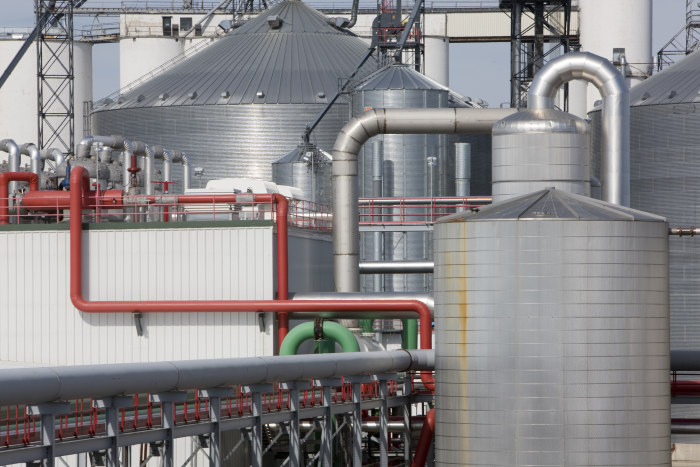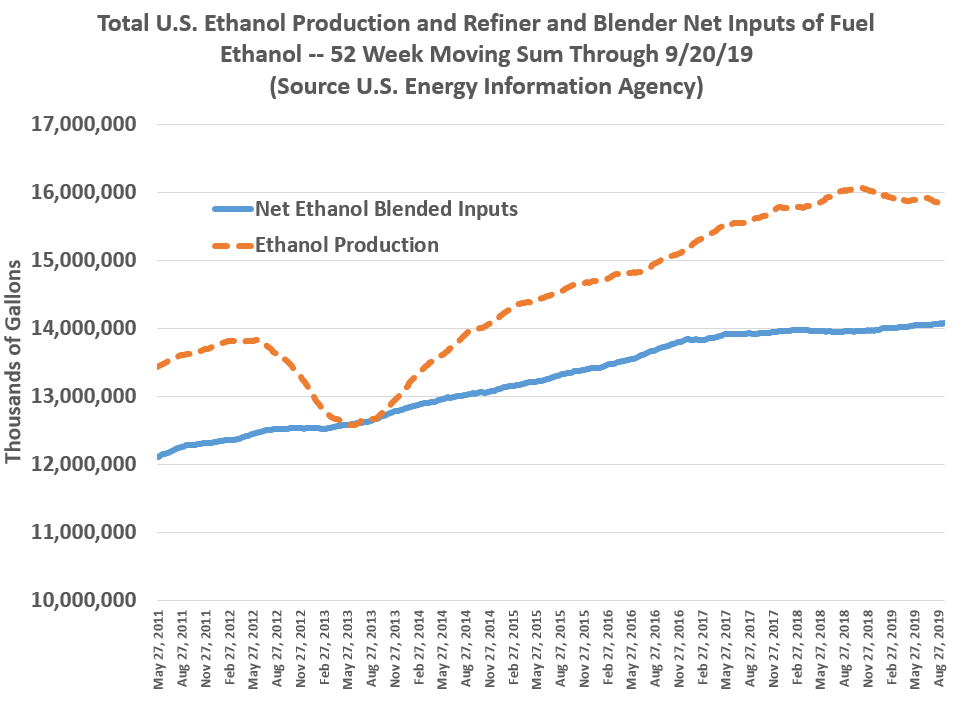Iowa State University economist Dave Swenson challenges the conventional wisdom on a hot political topic. -promoted by Laura Belin
The sky is falling and Midwest rural economies are in danger of collapse. So say the nation’s ethanol producers, corn farmers, and like-minded politicians.
Their collective fingers are pointing at the federal Environmental Protection Agency’s granting of 31 waivers to U.S. refineries lowering the amount of biofuels they are required to blend into the petro-fuels they distribute. The waivers, the stakeholders claim, are the cause of a string of biorefinery closings and idlings.
Working through this, however, does not lead one to necessarily conclude that the infamous 31 waivers are the chief culprits.
The Current Controversy Timeline
1. The EPA announcement of the waivers on August 9 was reported widely, causing an immediate reduction in ethanol prices (which have since rebounded) and corn. Those price declines, however, were not based on specific volume reduction information, nor did the announcement indicate whether the waivers were for ethanol or for biodiesel.
2. The ethanol industry and its stakeholder interests complained loudly of what they felt was the administration’s failure to adequately promote ethanol and farm sector priorities. Within days, there were reports of ethanol plants closing or suspending production. The Wall Street Journal quoted an official of the Renewable Fuels Association as saying the industry was enduring “probably the worst downturn [it had] seen in the industry’s history.”
That story yielded two important situational conclusions. First, the industry had an accumulating oversupply of ethanol. Second, it had been operating collectively in the red for over a year, according to analysts.
3. Iowa has more ethanol refining capacity than any other state. Predictably and promptly, Governor Kim Reynolds called the president to complain about the ethanol waivers and then traveled to D.C. to lobby the administration directly. All of the state’s nationally serving elected officials chimed in. So did former governor and now U.S. ambassador to China, Terry Branstad, who used a home visit during Iowa State Fair time to impress upon the president just how important it was politically to keep farmers happy.
4. By mid-September, Reynolds announced she’d secured a verbal commitment from Trump to fix the ethanol waivers and that she was taking the administration “at their word” that they would be rolled back. Still, no one knows either the types of waivers that were issued or the volumes that were involved. In short, while all of this was going on, there was no announced supply and demand volume changes informing the lobbying efforts or the markets.
5. Given that information void, claims were voiced that the EPA’s actions threatened to cost the industry as much as 4.6 billion gallons in ethanol demand. That dire scenario was first reported in Ethanol Producer Magazine, which had summarized an alternative ethanol forecast from the Food and Agriculture Policy Research Institute (FAPRI) model at the University of Missouri. The FAPRI forecast, after factoring in assumptions that the EPA would maintain its current pattern of waivers into the future, among a set of other negative suppositions, would result in a reduction of final domestic ethanol demand of 781 million gallons of ethanol annually from 2018 through 2023.
6. Farmers and biofuels producers continue to get mixed signals, for sure. On one hand, the Trump administration has been much more profligate in granting blending waivers than had been practice during the Obama administration. That would have been of growing concern and consternation to biofuels producers and to corn farmers.
On the other hand, the administration did announce in May that it was eliminating seasonal restrictions, which had limited E-15 blends during summer months. That move was widely cheered by farm groups, and a spokesman for the American Farm Bureau Federation noted that it would “create new demand that farmers desperately need.”
The Trump administration gives with one hand and takes away with the other.
Analysis
Here is a handy link to weekly energy reporting, which allows one to continually monitor ethanol industry production, the amount blended into the nation’s fuel supply, and ending stocks.
• The nation’s ethanol industry ramped up production more than a year ago at a pace significantly in excess of demand. Owing in part to ongoing trade difficulties and their own production decisions, the industry found itself clearly showing operating losses for at least the past year and continues to do so. Numbers reflecting poor margins and impending output cuts were reported nearly a month before the EPA’s waiver announcement in August.
• Ethanol inventories were generally high over 2018 and saw no appreciable declines into this year. By the end of July 2019, ending stocks were 24,500 thousand barrels – about 15 percent higher than the same time a year before.
• Domestic ethanol demand continued to climb, albeit slowly, through the end of September 2019. In all, and expressed on an annualized basis, 14.07 billion gallons of ethanol had been blended into the nation’s full supply by September 20, 2019, which was about 0.08 percent more than the same measure the year before (see the following graphic).
• Yet U.S. ethanol production grew substantially faster than demand. As again expressed on an annualized production basis, the industry produced 3.3 percent more ethanol by November 2018 than it had in August of 2017.
In short, the industry, for reasons that are internal to it, rapidly increased production more than a year ago even though growth in domestic demand was muted and, importantly, clearly known (see the following graphic).
• Significant oversupply led to declines in the prices of ethanol, which then squeezed the margins of many plants. Less profitable plants would be the first to close or idle, and the less profitable plants would be those that were older, smaller, perhaps not as ideally located relative to corn supplies, or those owned by firms that were souring on the corn ethanol market. For example, corn processing giant Archer Daniel Midlands was reported to be considering spinning off its three very large dry milling operations before the latest waivers announcement.
Conclusions
The nation’s ethanol industry expanded production in anticipation of better markets. Those markets–whether domestic or export-based–did not materialize, resulting in more ethanol produced than needed.
While the industry is surely the victim of EPA and Trump administration reneging on previous commitments, available evidence shows those actions do not come close to explaining the magnitude of distress the industry is going through currently.
In sum, most of the industry’s present woes look to be due to its own (likely irrational) exuberance regarding expected demand for its product.
This crisis is primarily supply-driven, not demand-driven, even though the ethanol industry would have us believe the reverse is true.



4 Comments
Excellent post!
In addition, we already know from years of good research that the ONLY way we Iowans can even hope to have clean water someday is if some of the land now planted to rowcrops is put instead into other uses that protect water, including wetlands, buffers, prairie strips, bioreactors, grassed waterways, etc. But instead of turning that knowledge into policies that protect both water and soil, we are producing a flood of corn ethanol. It’s as if a demented Marie Antoinette had declared “Let them drink gasoline.”
And I doubt if Trump is really shaking in his shoes about the farmer vote. A FARM JOURNAL PULSE poll taken in September indicated that 76% of farmers support Trump, with 55% described as “strong supporters.”
I greatly appreciate the Iowa farmers who are not Trump supporters and/or are doing what should be done on farms for soil, water, and biodiversity. They deserve more public recognition and support than they get. But they are a small minority.
PrairieFan Wed 2 Oct 12:17 PM
Food source
I like ethanol. It’s a cleaner fuel source. The irony is that it is a food source.
woodbury1 Wed 2 Oct 12:55 PM
Corn ethanol is cleaner than fossil fuels
Unfortunately, fossil fuels set a low bar. The real level of “clean” of corn ethanol depends largely on how sustainably corn is raised, and conventional corn-growing in Iowa leaks topsoil and nutrients like crazy.
PrairieFan Wed 2 Oct 2:31 PM
Over-production, the perennial problem for farmers
Excellent analysis by David Swenson and an excellent solution by PrairieFan. The best solution to problems in the agriculture economy has always been to reduce supply. As PrairieFan points out, reducing the acres in production with wetlands, buffers, prairie strips etc not only lessens risk of overproduction it has a huge public benefit of cleaner rivers and streams. The benefit of limiting agricultural production doesn’t only apply to land, it applies to hogs and poultry too. Farmers would find broader political support if voters could fish and swim in our rivers and lakes too.
miketram01 Thu 3 Oct 8:05 AM